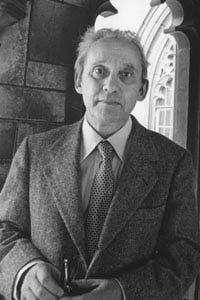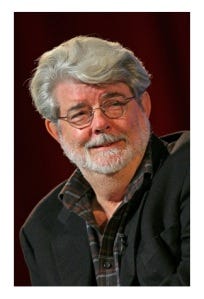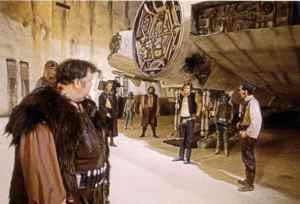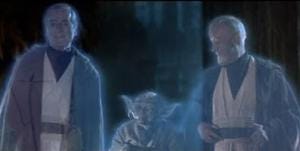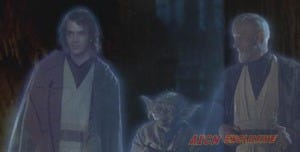Better Hermeneutics through Star Wars
As it is now November, my mom recently asked me what I would like for my birthday. In mulling this over, it occurred to me that I don’t own a set of the original Star Wars trilogy. I’m a fan of the films, and I’ve thought about getting a set previously. Yet the fact is that getting one is not necessarily an easy decision. The first question is what version of the trilogy to get.
Setting aside the question of format, there have been three DVD releases of the original trilogy: the Special Edition (2004), the unaltered original release (2006), and the “Complete Saga” edition (2011). Each of these sets is slightly different, with changes ranging from digital re-mastering and audio improvements to added (and even altered) scenes. Moreover, even these three releases don’t cover the full sweep of changes made to the original films since their theatrical release. For example, in its 1977 theater debut, the original film didn’t have “Episode IV” or “A New Hope” in the opening crawl – this was only added in its 1981 re-release.
While the variety of releases might complicate picking one to ask for as a birthday gift, it also offers an interesting foray into the field of hermeneutics. According to French philosopher Paul Ricoeur, hermeneutics is “the theory of the operations of understanding in their relation to the interpretation of texts.”1 More simply, hermeneutics wonders about how we interpret texts, but not only written texts. For Ricoeur, the same basic ideas apply when interpreting works of art, historical events, meaningful actions, and, yes, science fiction film franchises.
According to Ricoeur, when I interpret the Star Wars films, I explore the meaning that my encounter with the films discloses. The relevant question is not what George Lucas (who is, for all intents and purposes, the “author” of Star Wars) intended to say with the films, but rather the meaning that I discover within the films – a meaning that enables me to more fully understand myself.2
Further, Ricoeur states that a necessary step in producing a text or film is distanciation. This term means that the author publishes or releases the text; there is, quite literally, distance between the text and the author. This release is necessary for the text to engage a wider audience. This process “renders the text autonomous with respect to the intention of the author. What the text signifies no longer coincides with what the author meant.”3
In releasing the Star Wars films, Lucas (as the author) surrenders control over the meaning of the films. The public is free to engage the film, interpreting it in whatever way they see fit, quite apart from whatever Lucas may have intended. Ricoeur allows that the author can respond to these interpretations (“For it is when the author is dead that the relation to the book becomes complete and, as it were, intact”),4 but even that response is not necessarily the definitive interpretation of the text. It is rather one among other possible readings. The author becomes another interpreter of the text; Lucas becomes another viewer of Star Wars
It is safe to say, however, that Lucas disagrees with Ricoeur on this point. In fact, Lucas seems to oppose Ricoeur’s idea of distanciation altogether. Of his experience as a filmmaker, Lucas said
In essence, films never get finished, they get abandoned. At some point, you’re dragged off the picture kicking and screaming while somebody says, “Okay, it’s done.” That isn’t really the way it should work.
Lucas viewed his work on Star Wars as incomplete – as abandoned. Lucas doesn’t think releasing the films releases them from his interpretive control, but rather that he still exercises a constructive, editorial, and interpretive dominance over the franchise.
Some parts of the story that he abandoned are no doubt due to limitations in technology (Lucas had intended for Jabba the Hutt to appear in the original film, shooting a scene with a stand-in that would ultimately be added with the Special Edition release). While such changes might rankle purists, they don’t necessarily affect the interpretation of the film.
Yet some changes do. While the internet meme “Han Shot First” is a rallying cry among those upset at Lucas’ changes to the original films, I think a far more potent example comes at the conclusion of Return of the Jedi. Luke Skywalker, amidst celebrating the demise of the Galactic Empire, looks over to see his two mentors – Obi Wan Kenobi and Yoda – who appear to him as “force ghosts”.
Joining them is the force ghost of his father, Anakin Skywalker – known throughout the original trilogy as the antagonist Darth Vader. Anakin is portrayed in this film by actor Sebastian Shaw, including the scene when Luke removed Vader’s helmet and the two reconcile. By having Shaw portray Anakin’s force ghost, looking approvingly at his son alongside his one-time Jedi friends, the scene suggests that Anakin has reached redemption. The entire narrative arc of the original trilogy has come to completion. Anakin’s evil past is not forgotten but rather forgiven, transformed by the power of his son’s love.
In 2000, actor Hayden Christensen was cast to play the young version of Anakin. In the Special Edition releases of Return of the Jedi that followed this casting choice, the redeemed Anakin was thus depicted by Christensen and not Shaw. In so doing, the scene suggests that Anakin’s redemption returns him to a prior state, an as-yet uncorrupted state. In other words, Anakin is not so much redeemed as returned to a pre-fallen state. By making this change, Lucas undermines the impact of the redemption narrative in Star Wars. Redemption no longer consists in transforming something broken but rather turning back the clock to a time before the breaking. The goal in this change was not to depict just the prettier, healthier version of the character (if it had been, Alec Guinness could just as easily have been replaced by Ewan McGregor). The effect of it, however, seems to suggest that Anakin’s life as Darth Vader simply didn’t matter.
Hermeneutically, then, Lucas’ ongoing efforts to tweak, to edit, to change the Star Wars franchise turns the films into an unstable text. Not only can there be no definitive interpretation of Star Wars, but there is no definitive Star Wars to interpret. Rather, Lucas’ unwillingness to let the franchise go – to accept distanciation – has rendered it a messy and at times contradictory narrative. While these changes often annoy some of the franchise’s biggest fans (the reaction to the changes in the recent Blu-Ray release demonstrate this), it also serves as an instructive example for thinking about the relationship between the author and the text.
Paul Ricoeur, Hermeneutics and the Human Sciences: Essays on Language, Action, and Interpretation (New York: Cambridge University Press, 1981), 43.
Ricoeur 142
Ricoeur 139
Ricoeur 147




